News
Car AC refrigerant recharge: Here's a detailed DIY guide
If the vehicle is over 6-8 years old & the air conditioner’s cooling effect has reduced over time, there’s a good chance that this is due to the lack of refrigerant in the system.
BHPian Gannu_1 recently shared this with other enthusiasts.
I recharged the refrigerant in my Polo’s AC system some time back. The AC’s cooling effect in my car had noticeably reduced and I could feel it during my daily drives. I began hearing a strange hissing noise from the vents which wasn’t there before. I decided to read up more on this, how the refrigerant on car’s AC systems are recharged and figured out that if the system is running low on refrigerant and there are no other issues with the other components of the system, topping it up is pretty simple and restores the cooling performance. Putting up a dedicated, detailed DIY thread to our repository for reference.
Disclaimer
I am not an HVAC expert and whatever I did was purely for the learning and experience.
Background
When the issue cropped up, I did a quick check on all the related components of the HVAC system:
- Compressor - turns on when I press the AC button and I could hear a distinctive ‘click’ from the relay. Upon physical inspection, there were no issues with the drive belt driving the compressor. It was also replaced during the timing belt service. No other noise related to the pulley or bearing.
- Evaporator - assumed to be working fine. I did not see any water collected in the footwell or a clogged drain outlet. No visible frosting observed when viewed from the cabin air filter cavity.
- Condenser - assumed to be working fine. The fins were not clogged or dirtier than usual. I use the compressed air from these service centres and garages to clean the fins. Never did an alkali cleaning though.
- Expansion valve - assumed to be working fine. The expansion valve is installed outside the firewall/plenum chamber bulkhead.
- Blower - works fine. Spins at different speeds depending on the setting so the blower resistor had no complaints either.
- Dust and pollen filter - relatively clean. It was changed during the last service 5 months back and the recirculation mode is set to ON at all times so the car doesn’t draw fresh air from outside and therefore does not contaminate the filter quickly.
The last thing left to check was the refrigerant in the system.
The lack of refrigerant in the system can result in ineffective cooling. Despite being completely sealed systems, refrigerant levels drop over time as the rubber seals/o-rings in the connectors of the rubber hoses and metal tubes wear out and causes the refrigerant to gradually leak out over time. If there is a puncture in the metal tubes or hoses, or the condenser coil due to a nasty stone hit, the refrigerant would again leak out. Sometimes, gas leaks out from the Schrader valves present in the charging ports of the car in extremely minor quantities. But if the car is over 6-8 years old and the AC’s cooling effect has reduced over time, there’s a good chance this is due to the lack of refrigerant in the system; as it turned out to be in my case. Over all these years, I have never had an AC refrigerant recharge. But at this stage, I do not know if there are any leaks in the system.
Tools required
- AC manifold setup
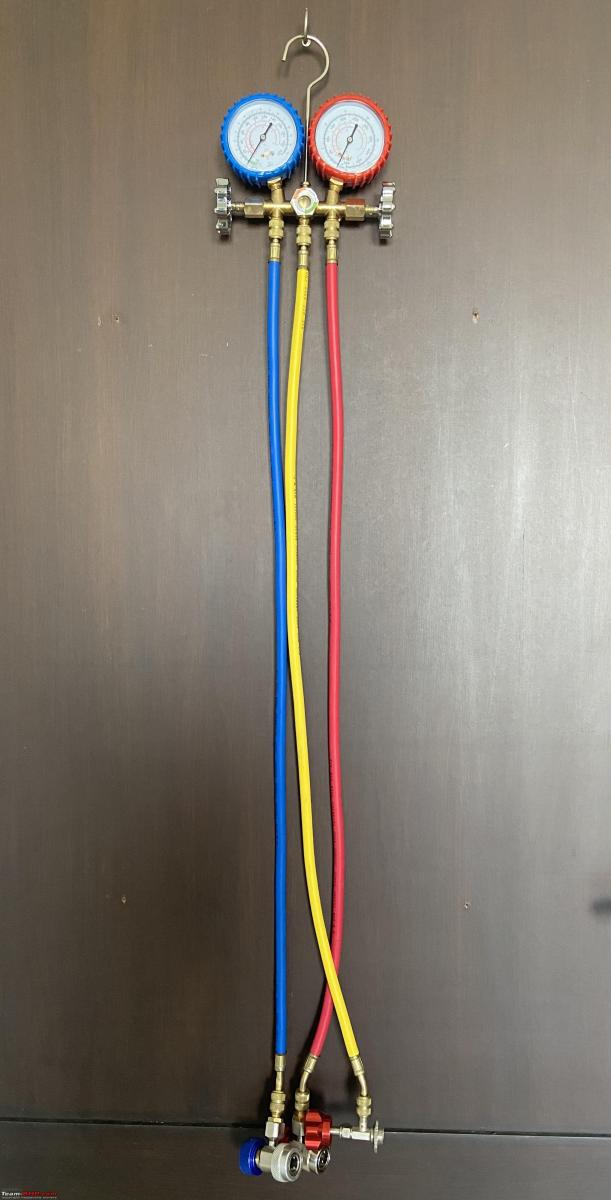
- Probe thermometer or the one in your digital multimeter (DMM) if you have the option.

Consumables required
- R-134a refrigerant can - 450g (costs Rs 430 for a can; sufficient for a hatchback)

The type of refrigerant used in the car and the quantity is indicated in a sticker stuck on the engine bay or on the hood.

PPE required
- Safety goggles
- Nitrile gloves
The AC manifold setup
The AC manifold setup is used to recharge or evacuate the refrigerant from the system and measure the pressures at the low-pressure (LP) and high-pressure (HP) lines. It has a brass manifold with 2 pressure gauges - one for the low pressure side marked in blue (marked from 0 - 220 psi) and the other for the high pressure side marked in red (marked from 0 - 500 psi).

There is a valve mounted on either side which controls the flow of refrigerant through the 3 threaded ports on the manifold. While charging the refrigerant, the valve next to the LP side is opened and the refrigerant flows from the refrigerant can (stored under high pressure just like your LPG cylinder) to the system (low pressure side) in the liquid phase. The manifold has a gauge glass at the centre which shows the flow of refrigerant while charging the setup.
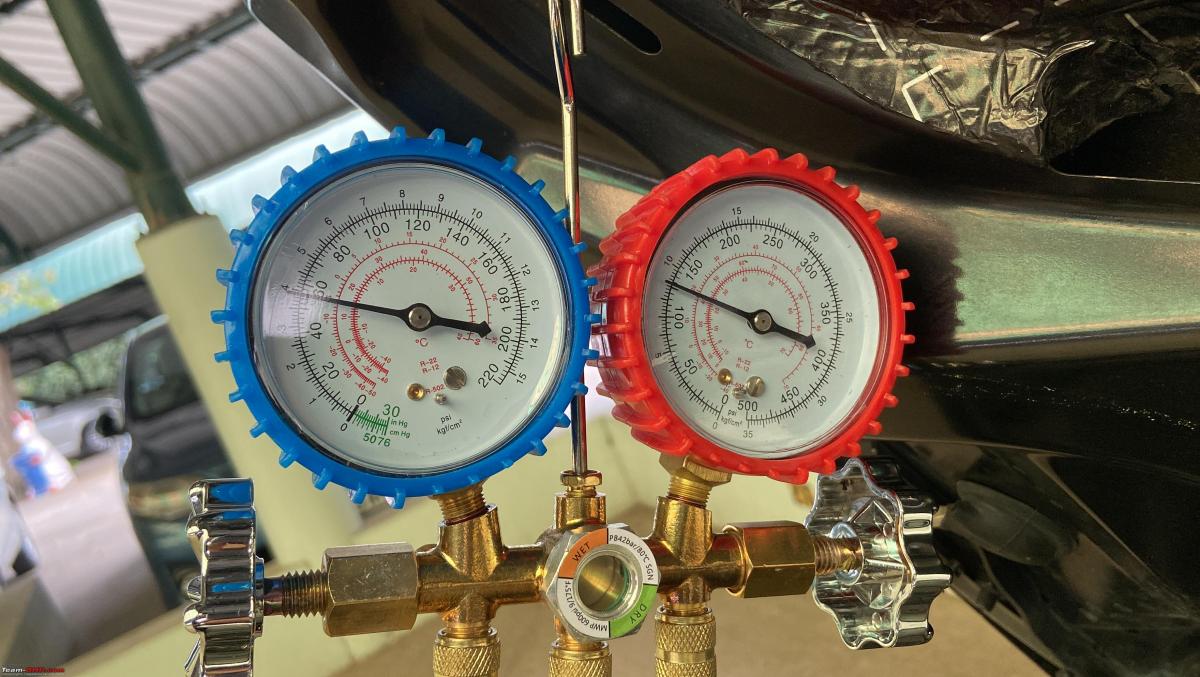
Color coded hoses are used to connect the manifold to the system. Just like the pressure gauges, blue for the LP side, red for the HP side and yellow for charging or evacuating. Color codes are for easy identification - otherwise, the hoses are identical in terms of connectors and size.

These hoses have threaded Schrader valves at the ends just like the ones in the tyres. Press the central pin and the gas escapes.

To connect the hoses to the car’s LP and HP ports, quick coupler fittings are provided. These are also color coded - blue for the LP side and red for the HP side.

The quick couplers are foolproof because the openings are different. The LP quick coupler has a smaller opening while the HP one has a larger opening. One cannot fit the wrong fitting to the port.

These quick couplers snap onto the charging ports in the car, just like the LPG gas cylinder regulators we have at home.
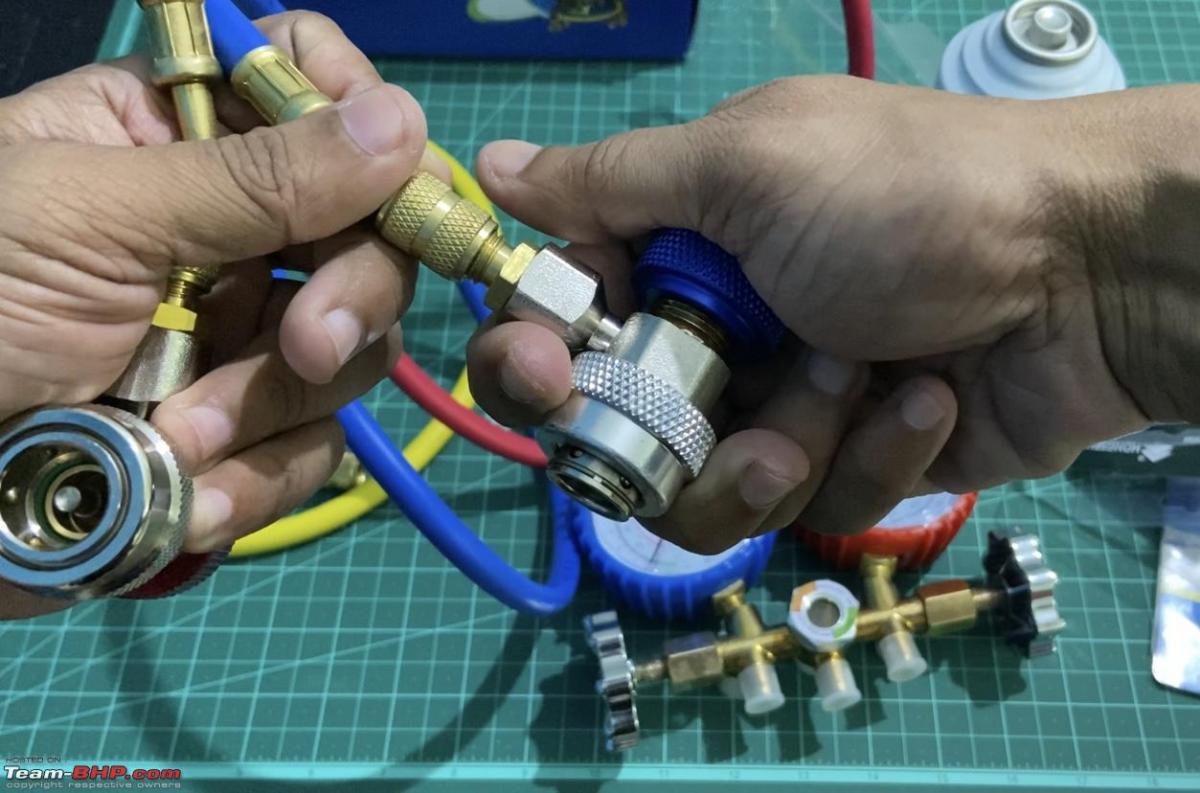
While charging the system, the yellow hose connects to the refrigerant can using a threaded valve. The valve has a pointy end:
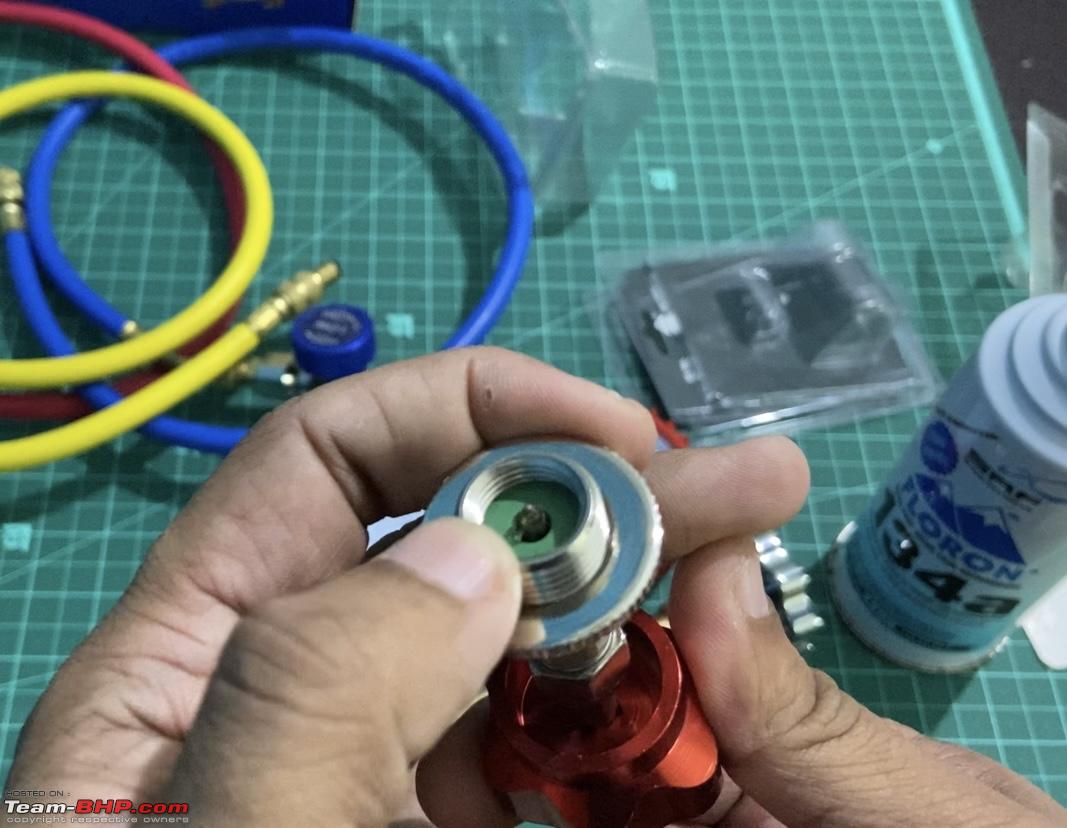
Screw the valve in the clockwise direction and it pierces the can, open the valve in the counterclockwise direction and the refrigerant escapes out. Take extra care to ensure the valve is opened before screwing it to the can; otherwise, it’ll pierce the can and refrigerant would leak out!
While recovering the refrigerant or pulling a vacuum on the system, the yellow hose is connected to a recovery unit or vacuum pump respectively. Changing the compressor/condenser coil/evaporator coil/leaking hoses or tubes demands evacuating the refrigerant from the system.
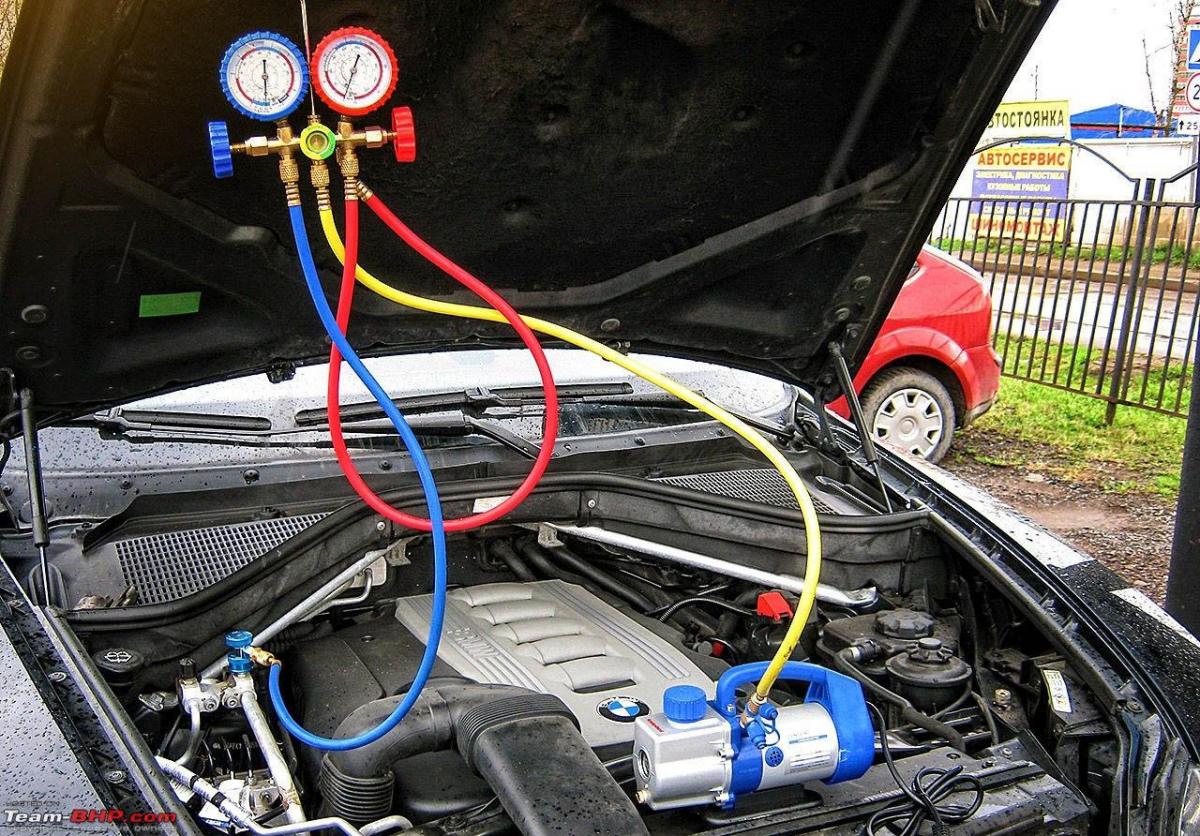
(Source: Google Images)
The manifold has dummy threaded ports at the back…:

...to park the hoses when not being used. This will prevent dirt and dust from entering into the hoses.

I sourced the complete manifold kit with the hoses and quick connectors from a neighbourhood car AC parts store for Rs. 2300. The good thing was unlike buying online, I could physically check the parts and their quality. Plus, the shop also agreed to replace a part if there was any leak but no other guarantee otherwise. Plus, the same setup can be used to charge the refrigerant in a home AC unit with the right refrigerant; not that I intend to for now but good to know this can be done with the same kit.
Procedure
- Start the engine, set the temperature to the lowest setting, blower to the highest speed and measure the temperature of the air from the vents using the probe thermometer for reference. I’ve used the one on my DMM.


As you can see, the air is not chilled enough.
- Pop up the hood and hang the AC manifold setup. Ensure that both the valves are closed. Hang the ref. can and screw the valve to the can (ensure the valve is open!).

- Find the LP and HP service ports from the AC system in your car.
LP port - smaller port on a larger pipe
HP port - larger port on a smaller pipe.
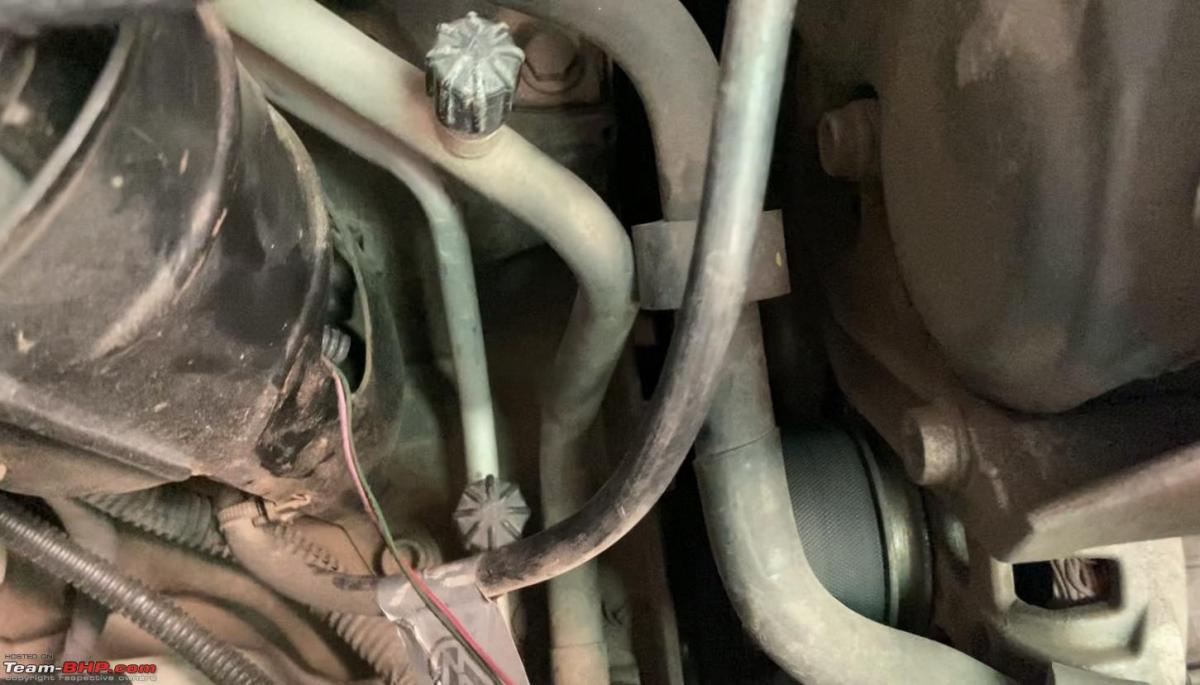
Remove the dust caps from the ports. Keep the dust caps secure.
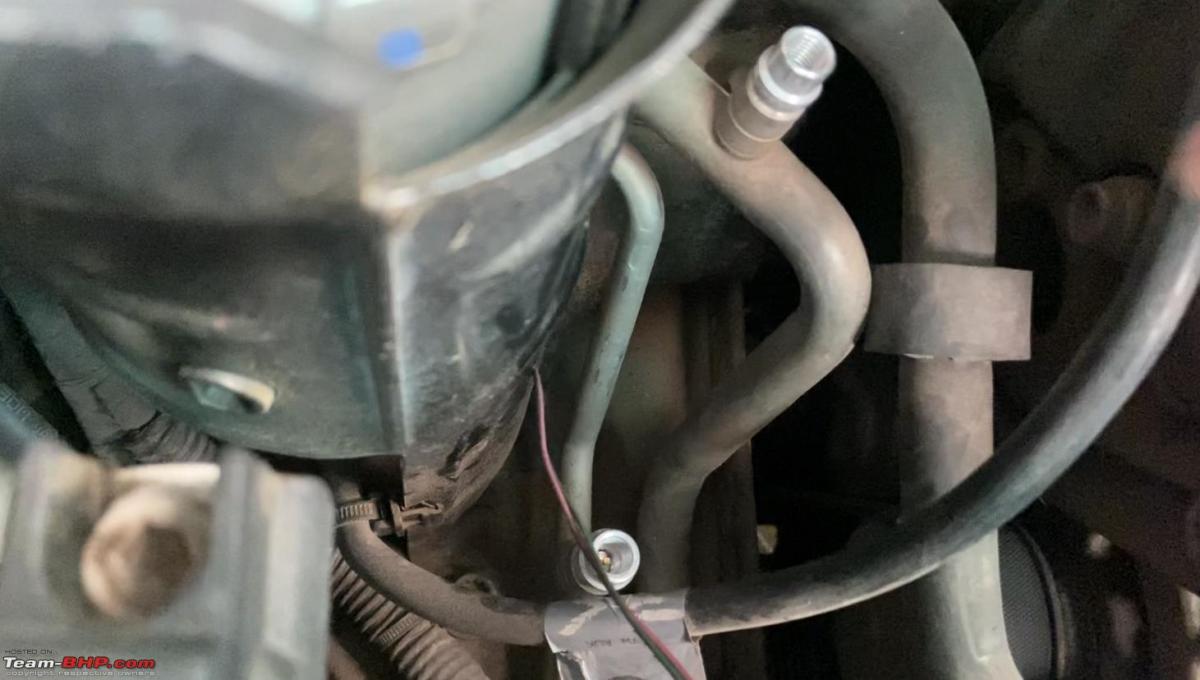
- Connect the LP/blue quick coupler fitting to the LP port and the HP/red quick coupler fitting to the HP port. Take care to ensure that the quick couplers are closed while connecting them.

- Gently open the valves on the quick couplers and the reading would show up on both the pressure gauges. There is no need to open the valves on the quick couplers completely. Once the gauges show the reading, that’s sufficient.

On that note, even if the valves on the manifold unit are closed, the readings will show up on the gauges as these valves control the flow of refrigerant from the centre port to the LP or HP ports.
- Have a partner start the engine, rev it to 1500 rpm and check the pressure readings on both the gauges. At higher engine speeds (like in real life situations when the car is in motion), the compressor's pulley would be spinning properly and this would give a proper reading on the gauges.

Measure the ambient temperature and compare the reading with the pressure-temperature chart of R134a below:

In my case, the ambient temperature was around 28°C.

Corresponding to this temperature, the LP gauge should read between 45 - 50 psi and the HP gauge should read between 190 - 230 psi from the reference chart. The LP gauge reading is okay but as evident from the HP gauge, the reading is 135 psi which is low and indicates the HP/discharge side does not have sufficient refrigerant flow.
- Wear the safety goggles and a pair of nitrile gloves before working on the ref. can as direct contact with the refrigerant can result in frostbite.

- Screw down the valve on the ref. can completely to puncture it and turn it back in the opposite direction to let the refrigerant flow through the yellow hose to the manifold unit.

The yellow tube now has a combination of ambient air + refrigerant. Air/moisture is not good for the system and must be purged from the line before charging. Gently unscrew the connector of the yellow hose at the manifold end to purge the air from the hose until some refrigerant comes out.

Screw the connector back firmly.
- Gently open the LP side valve on the manifold unit to charge the system with the refrigerant.

You will notice the flow of refrigerant in the liquid phase through the gauge glass on the manifold:

Close the valve. All the refrigerant from the can should not be charged into the system at once!
- Notice the reading on both the gauges. The reading on the HP gauge (discharge side) should begin rising gradually as the refrigerant is being charged into the system.

- For the measured ambient temperature (28°C), find out till what value should the HP gauge needle should climb from the R134a temperature pressure reference chart. It should be between 190 - 230 psi. Open the LP valve to charge the refrigerant in short intervals so the HP gauge needle climbs up to this value and stop.

Additional refrigerant does more harm than good - affects cooling performance, can damage the compressor, valves and the seals. Please be careful not to open the LP valve completely in one go!
- Check the temperature from the probe thermometer inside the cabin. It should now read a lower temperature suggesting that the charging process went properly.

If you still have issues, you may want to visit a good car AC service garage/technician - unlike other car garages, these guys can quickly diagnose an issue related to the AC system and suggest a proper course of action for a shorter turnaround time and expense. I could have done this too but preferred to do this on my own just to know the process and learn from it.
- For those who prefer a video tutorial, here it is.
Thanks for reading guys. Trust this was useful. Let me know if you have any comments or feedback or if I've erred in my assessment somewhere.
PS: If you're interested, here's a very handy training manual that I got off the internet about car AC systems.
Check out BHPian comments for more insights and information.






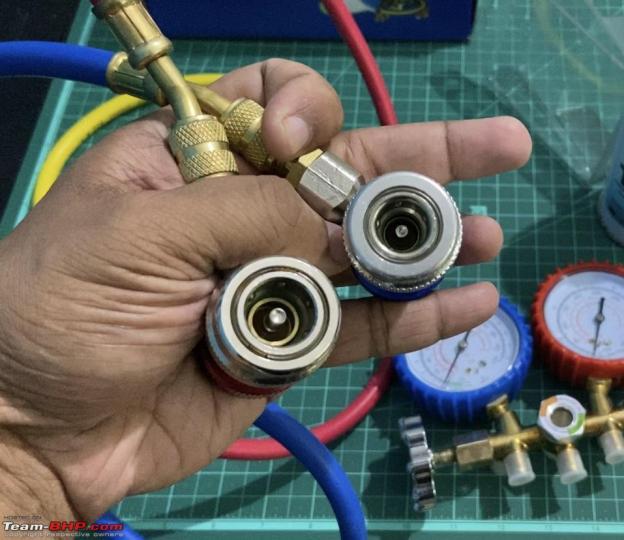






_2.jpg)












